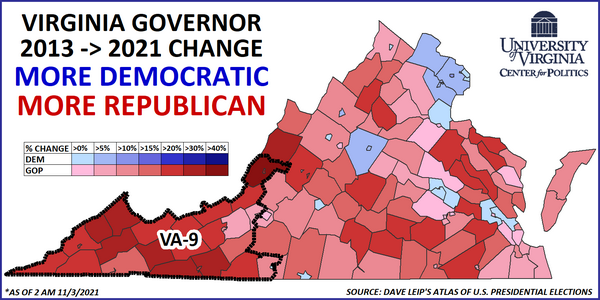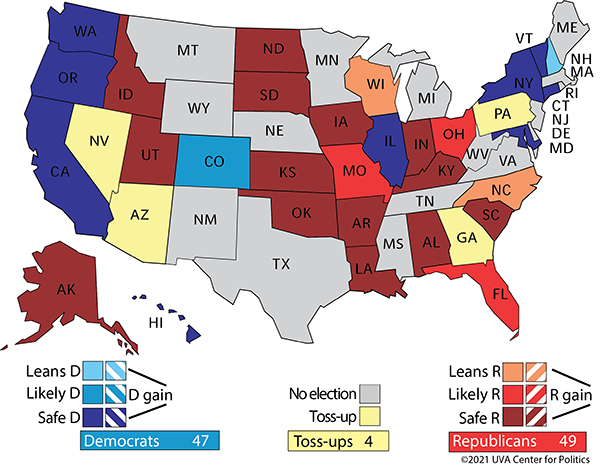| Dear Readers: Join us tomorrow, Thursday, Nov. 4, from 6:30 p.m.* to 8 p.m. for our annual American Democracy Conference. The virtual event will begin with a presentation by Project Home Fire’s Larry Schack and Mick McWilliams on our ongoing polling and data analytics project. They will be followed by discussions on the state of politics moderated by Carah Whaley, Assistant Director of the James Madison Center for Civic Engagement, and featuring UVA Center for Politics resident scholars Jamelle Bouie, David Ramadan, and Tara Setmayer; former Rep. Barbara Comstock (R, VA-10); and Crystal Ball Managing Editor Kyle Kondik.
The free, virtual event will be available at this link: https://livestream.com/tavco/uvacfp-adc2021 *The start time is now 6:30 p.m., not 6 p.m. — The Editors |
KEY POINTS FROM THIS ARTICLE
— Republicans swept Virginia on Tuesday night, winning statewide for the first time in a dozen years and running much better than they did in the Trump years.
— The result helps confirm a poor environment for Democrats, which if replicated next November could help the Republicans win back the House and the Senate.
— As such, we’re changing several Senate ratings to reflect improved odds of Republicans flipping that chamber next year. The changes are shown in Table 1:
Table 1: Crystal Ball Senate rating changes
Virginia and its revelations
There were a lot of electoral questions that the Virginia gubernatorial race was well-positioned to help answer. Could Republicans make up ground in the suburbs with Donald Trump no longer in the White House? Would Republican voters turn out in force with Trump gone? Could Democrats fall even further in heavily white, rural/small town areas? Was the history that suggested holding the White House is a burden for the presidential party in Virginia still operative?
Unfortunately for Democrats, and fortunately for Republicans, the answers to all of these questions were a resounding “yes.”
As the Crystal Ball projected on Monday, Glenn Youngkin (R) won the Virginia gubernatorial race last night, defeating former Democratic Gov. Terry McAuliffe. Youngkin’s win was part of a larger GOP sweep, as fellow Republicans Winsome Sears and Jason Miyares captured the lieutenant governor and attorney general posts, respectively. It also appears, as of this writing, that Republicans have taken the majority in the state House of Delegates, claiming at least 51 of the chamber’s 100 seats. Democrats hold a narrow majority in the state Senate — given the overall tenor of the night, they were lucky that the upper chamber wasn’t up this cycle.
Needless to say, this is a horrible result for Democrats, and for the White House. Youngkin’s 2-point victory (based on the results as of Wednesday morning) represented an 11-point shift in the GOP’s favor from 4 years ago, when now-Gov. Ralph Northam (D) won by almost 9 points. Going back a bit further to 2013, McAuliffe won by 2.5 points that year — last night’s result was a near-mirror image of that. Map 1 compares McAuliffe’s showing 8 years ago to his result last night.
Map 1: Virginia gubernatorial races, 2013 vs 2021

An engaged GOP base delivered Republicans even bigger landslides than usual in rural central and western Virginia. In 2013, McAuliffe lost the 9th Congressional District, in the southwestern corner of the state, by about 30 percentage points. Last night, as almost every county in VA-9 saw double-digit redshifts, McAuliffe’s deficit there fell to about 50 points. Just north of VA-9, there was evidence that Youngkin energized Republicans in the Shenandoah Valley, a traditional GOP bastion.
As Map 1 shows, Youngkin’s gains were not just limited to whites in Appalachia. In Southside Virginia, some heavily Black counties saw their Democratic lean erode — Sussex County, which is majority-Black by composition, supported McAullife by 18 points in 2013 but came close to flipping.
While McAuliffe did make gains in many large suburban localities compared to 2013, his margins there were still relatively unimpressive, at least by Trump-era standards. Loudoun County, a large suburban county that the Youngkin campaign targeted, swung 6 percentage points to McAuliffe — however, compared to Northam’s 2017 showing, he still lost ground in almost every precinct.
Going into the election, the conventional wisdom seemed to be that lower turnout would benefit Youngkin. In 2014, Republicans nearly upset Sen. Mark Warner (D-VA) in a low turnout midterm. The higher the turnout, the more “presidential” (read pro-Democratic) it seemed the electorate would become. But high turnout did not prove a hindrance to Youngkin: There were at least 3.3 million votes cast, by far the biggest Virginia gubernatorial turnout ever (higher even than the high-turnout blowout Democratic victory 4 years ago).
More broadly, Youngkin was in the right place at the right time — he was the GOP nominee in a GOP-leaning environment. But he also seemed to outmaneuver McAuliffe on issues such as education and taxes.
While there were many factors that fell into place for Republicans, to us, it is hard to ignore old-fashioned “fundamentals.” Since August, Biden’s national standing has weakened. That decline, combined with the usual headwinds the president’s party faces in off-year elections, helped fuel Youngkin’s 12-point net improvement over Trump’s 10-point loss in Virginia last year. As we have noted before, this type of shift is not out of the ordinary for Virginia gubernatorial races. Gov. Phil Murphy’s (D-NJ) surprisingly close race in the lower-profile and still-uncalled New Jersey gubernatorial contest also indicates that the poor Democratic environment was a main driver of the party’s poor 2021 Election Night.
With that in mind, let’s look ahead:
Our Senate rating changes
Look, we know the midterm is still a year away. There are plenty of things that might change. Biden could find ways to improve his approval rating. Some of the problems that appear to be hurting Democrats right now — gas prices, inflation, supply-chain problems, DC infighting, COVID-19, and more — could subside over the next year. Other issues may become paramount: McAuliffe struggled to make abortion an issue in Virginia, but the Supreme Court gutting Roe vs. Wade next year would make abortion a much bigger deal next year, which could give Democrats a potent electoral issue. Trump may be a more important figure, taking some of the focus off of Biden and reminding some suburban voters why they soured on the GOP.
However, with all those caveats out of the way, it must be said: If Biden’s approval rating is in the low-to-mid 40s next year, as it is now, everything we know about political trends and history suggests that the Democrats’ tiny majorities in the House and Senate are at major risk of becoming minorities.
So it’s a good time to reevaluate our assessment of the Senate. Given the usual presidential party midterm drag, and the poor environment, our ratings are just too bullish on Democrats. So we are downgrading Sens. Mark Kelly (D-AZ), Raphael Warnock (D-GA), and Catherine Cortez Masto (D-NV) from Leans Democratic to Toss-up. While we have not been particularly impressed with Republican candidate recruiting in these races — former NFL star and Trump favorite Herschel Walker seems like a particularly risky choice in Georgia, assuming he wins the nomination — these moves are almost entirely about the environment. Moreover, even if Republicans don’t end up running strong candidates in these races, all 3 states are markedly less blue than Virginia.
“Toss-up” doesn’t mean we think these Democratic senators will necessarily lose — it just means we don’t think the environment suggests they do not deserve to be considered even modest favorites anymore. We will dig into these races in more detail in future issues of the Crystal Ball, but we thought now was a good time to make these changes, given what Tuesday night’s results suggested about the broader political mood. Sen. Maggie Hassan (D-NH) retains a Leans Democratic designation in New Hampshire, but we will move her race to Toss-up when and if Gov. Chris Sununu (R-NH) launches his long-rumored challenge against her.
We are also moving Sen. Michael Bennet (D-CO) from Safe Democratic to Likely Democratic. He could potentially be vulnerable if 2022 turns into a GOP mega-wave.
Map 1 shows our full, updated Senate ratings.
Map 1: Crystal Ball Senate ratings

This leaves a Senate with 49 races either not on the ballot or at least leaning to the Republicans, 47 not on the ballot or at least leaning to the Democrats, and 4 Toss-ups: Democratic-held Arizona, Georgia, and Nevada, and Republican-held Pennsylvania. Splitting the Toss-ups would give the GOP a 51-49 edge. This reflects a close race for the Senate, but one that Republicans are better-positioned to win, particularly if the environment remains as poor for Democrats as it clearly is right now.
